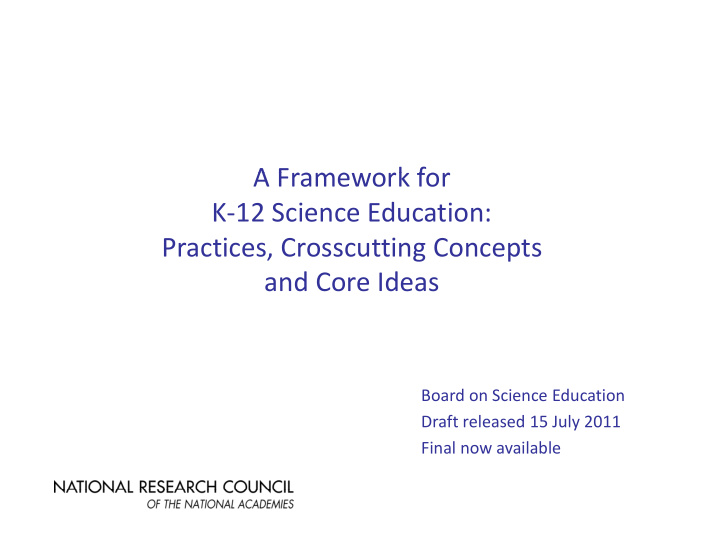



A Frame ork for A Framework for K-12 Science Education: Practices Crosscutting Concepts Practices, Crosscutting Concepts and Core Ideas Board on Science Education Draft released 15 July 2011 Final now available Final now available
Context Context • Education is US is a controlled at the state Education is US is a controlled at the state and local level. • Common Core Math and Language Arts • Common Core Math and Language Arts -- 47+ states choosing common standards Next Generation Science Standards N t G ti S i St d d • Stage 1 NRC Framework –July 2011 • Stage 2 Achieve Standards –under development, first public release soon p , p
Lead State Partners
Assessments Curricula Curricula Framework Standards Instruction Teacher P Preparation ti and development
Three Dimensions Three Dimensions • Scientific and engineering practices S i tifi d i i ti • Crosscutting concepts • Disciplinary core ideas
Some teacher preparation challenges • Elementary l Where do they meet the practices? y p How do they interpret the cross-cutting ideas? • High School C Connections across disciplines? i di i li ? Flexibility for new course sequences?
Goals of the Framework • Coherent investigation of core ideas across h f d multiple years of school • More seamless blending of practices with core ideas and crosscutting concepts
S i Scientific and Engineering Practices tifi d E i i P ti 1. Asking questions and 5. Using mathematics and defining problems computational thinking 2. Developing and using 6. Developing explanations models and designing solutions 3. Planning and carrying out 3 Planning and carrying out 7 Engaging in argument from 7. Engaging in argument from investigations evidence 4. Analyzing and interpreting 8. Obtaining, evaluating, and d data communicating information
Crosscutting Concepts 1. Patterns 2. Cause and effect: mechanism and explanation 3 3. S Scale, proportion and quantity l ti d tit 4. Systems and system models 5. Energy and matter: flows, cycles and conservation 6 6. St Structure and function t d f ti 7. Stability and change
Example energy Example: energy • How do we ensure a common language across disciplines? • How do teachers in one course build on knowledge gained in a different course? Physics teachers need to know how chemists, earth scientists and biologists talk about energy, as well as how physicists do, and use inter disciplinary examples where appropriate inter-disciplinary examples where appropriate. Teachers in all disciplines need to adjust their language around energy t toward a more common conception. d ti What college science courses help make these connections?
A core idea for K-12 science instruction is a A core idea for K-12 science instruction is a scientific idea that: • Has broad importance across multiple science or engineering disciplines or is a key organizing concept of a single discipline • Provides a key tool for understanding or investigating more complex ideas and solving problems • Relates to the interests and life experiences of students or can be connected to societal or personal concerns that require scientific or technical knowledge require scientific or technical knowledge • Is teachable and learnable over multiple grades at increasing levels of depth and sophistication
Disciplinary Core Ideas: Physical Sciences • PS1 Matter and its interactions • PS2 Motion and stability: Forces and interactions • PS2 Motion and stability: Forces and interactions • PS3 Energy • PS4 Waves and their applications in technologies for information transfer
Disciplinary Core Ideas: Life Sciences • LS1 From molecules to organisms: Structures and processes • LS2 Ecosystems: Interactions, energy, and dynamics • LS3 Heredity: Inheritance and variation of traits • LS4 Biological evolution: Unity and diversity • LS4 Biological evolution: Unity and diversity
Disciplinary Core Ideas: Disciplinary Core Ideas: Earth and Space Sciences • ESS1 Earth ’ s place in the universe • ESS2 Earth ’ s systems • ESS3 Earth and human activity
Disciplinary Core Ideas: p y Engineering, Technology and Applications of Science • ETS1 ETS1 Engineering design Engineering design • ETS2 Links among engineering, technology, science and society d i
Integrating the Dimensions g g • To facilitate students ’ learning the dimensions must be woven together in standards, assessments, curriculum and instruction. and instruction. • Students should explore a core idea by engaging in the practices and making connections to crosscutting ti d ki ti t tti concepts. Where do teachers learn to do this?
Key Components in the System that Need to be Aligned N d b Ali d • Standards • Curriculum and instructional materials C i l d i i l i l • Assessment • Pre-service preparation of teachers • Professional development for in-service teachers
Example: Teacher Preparation needs See recent PCAST reports S t PCAST t • Revised Science Courses, especially at intro level for elementary teachers i ll i l l f l h experience of the practices If teachers have never experienced data analysis, or argument from evidence how can they teach it? argument from evidence, how can they teach it? • Revised “Science Teaching Methods” courses
Free PDF version of A Framework for K-12 Science Education is available as of www.nap.edu p
Recommend
More recommend